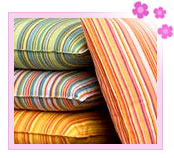Designs & Styles
Styling of printed fabrics are characterized by geometric prints, squares, circles, stylized florals, good luck symbols, horse shoes, wishbones, laurel wreaths, and ribbon and animal prints. Other popular styles are human forms with insect wings, butterflies, peacocks, women with flowing hair, the Iris flower, and fantasy type prints and moon and stars. Floral prints include roses, lilacs and morning glories were some of the new flowers that are in vogue.
Techniques
 Stenciling is restricted to single and very low volume prints, custom
windsocks and kites for example, where the graphic is too fine for applique,
or for large banners printed on synthetic fabrics. Block printing is the
method to create prints with a block of wood, copper or other material
bearing a design in intaglio with the dye paste applied to the surface is
pressed on the fabric and struck with a mallet.
Stenciling is restricted to single and very low volume prints, custom
windsocks and kites for example, where the graphic is too fine for applique,
or for large banners printed on synthetic fabrics. Block printing is the
method to create prints with a block of wood, copper or other material
bearing a design in intaglio with the dye paste applied to the surface is
pressed on the fabric and struck with a mallet. More recent printing processes include screen printing, a hand method especially suitable for large patterns with soft outlines, in which screens, one for each color, are placed on the fabric and the color paste pressed through by a wooden squeegee; spray printing, in which a spray gun forces the color through a screen; and electro coating, used to apply a patterned pile.


